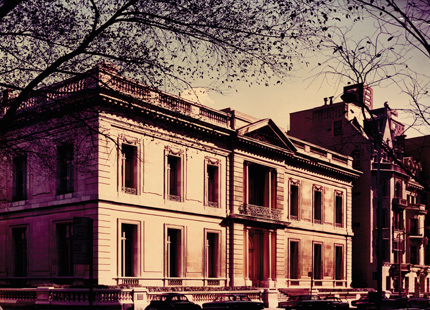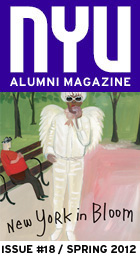architecture
Fifth Avenue’s Grande Dame
At 100, Duke House is a window into New York City history
by Megan Doll / GSAS ’08
At the Institute of Fine Arts, the very walls are a piece of architectural history. In a well-appointed marmoreal dining room that looks across Fifth Avenue to Central Park and the Metropolitan Museum of Art, students unpack their lunches. Across the main hall, they attend chandelier-lit lectures in a former ballroom. The upstairs bedrooms and vast closets that once stored socialite Doris Duke’s luxurious dresses now house volumes on art history. On the topmost floor, faculty members hold office hours in erstwhile servants’quarters.The mansion, which has been home to the Institute of Fine Arts, or IFA, for the past 54 years, will not only be the site of study but also its object as the institute celebrates Duke House’s centennial this year. Constructed between 1909 and 1912, the house is a notable survivor of the wave of modernization that swept New York City in the early 20th century. “These kinds of buildings are rare,” NYU historian Jon Ritter (IFA ’99) notes. “Most of them came down after World War II, or even earlier, in favor of the large apartment buildings that line Fifth Avenue now.” Indeed, the Landmarks Preservation Commission called Duke House “one of the last reminders of the Age of Elegance.”

To mark the occasion, faculty members are preparing a series of events, including public lectures and a seminar led by architecture historian Jean-Louis Cohen and the Frick Collection’s decorative arts curator, Charlotte Vignon, intended to peel back decades of history and survey the house’s former grandeur.
The stately limestone edifice, which stands at Fifth Avenue and East 78th Street, was built by Horace Trumbauer for James B. Duke, a tobacco tycoon whose substantial contribution to a college in Durham, North Carolina, prompted the college’s fourth name change to Duke University in 1924. Trumbauer and chief designer Julian Abele, one of the first prominent African-American architects, modeled Duke House after the Hôtel Labottière, an 18th-century mansion in Bordeaux, France.
Duke’s wife, Nanaline, and his daughter, Doris, donated the building to the IFA in 1958. Later that same year, the institute gave the now famous postmodern architect Robert Venturi his first commission: the renovation of Duke House. Venturi used a light touch, mounting the classroom furnishings—desks, bookcases, and the like—away from the walls, so as to leave the original paint, molding, and decorative flourishes undisturbed. Historian Ritter commends “this idea of modernizing [the space] for its new uses but also keeping the character of the old building.”
Venturi’s design will allow next fall’s seminar students to examine these modern additions alongside the original architecture. They will also learn about the furnishings and art collection once housed in the mansion before its donation. Professor Cohen explains: “Part of the idea is to reconstruct the house as it was in its age of splendor.”







